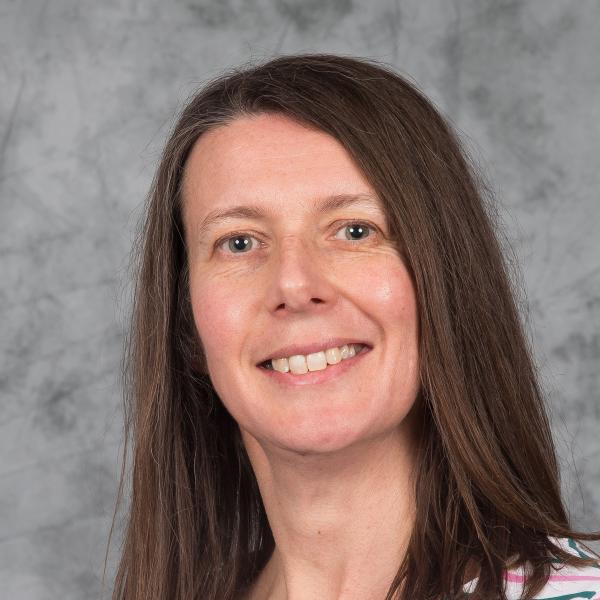Dr Nicola Green (she/her)
PhD FRMS
School of Chemical, Materials and Biological Engineering
School of Chemical, Materials and Biological Engineering
Senior Lecturer in Bioengineering
Biomedical engineering programme lead


+44 114 222 3932
Full contact details
School of Chemical, Materials and Biological Engineering
North Campus
Broad Lane
Sheffield
S3 7HQ
- Profile
-
I am a Senior Lecturer in Bioengineering. I obtained my first degree In Biochemistry and Genetics from the University of Nottingham and my PhD in Biotechnology from the University of Kent. After my PhD I trained and worked as a science teacher before returning to the academic research environment. I worked as a Research Fellow at the University of Nottingham, in the Laboratory of Biophysics and Surface Analysis, and as a Senior Scientist at Scancell, a Nottingham University biomedical spin-off company.
I joined the University of Sheffield 2006 as a postdoctoral researcher in biomaterials and tissue engineering and took charge of the Kroto Imaging Facility as Experimental Officer in 2010. I was appointed as Lecturer in Bioengineering in 2019 and Senior Lecturer in 2022.
- Qualifications
-
1998 PhD ŌĆō Biotechnology, University of Kent
1992 ŌĆō BSc Hons Biochemistry and Genetics, Nottingham University
- Research interests
-
My research aims to understand the interactions between biomaterials, cells and the environment that they are being cultured in. This allows me to use cells in the manufacturing process to create novel biomaterials containing both synthetic and biological components and leads to a better understanding of how materials will behave once they are implanted into the body to repair and replace damaged tissue. We also use this understanding to create better, more biologically relevant 3D models of specific tissues and diseases that can be used in the laboratory to improve the drug discovery pipeline and replace animal experiments.
Key research interests:
- Biohybrid scaffolds for tissue engineering: Scaffolds which incorporate biological components into synthetic scaffolds combine benefits from both and have significant clinical potential. This research seeks to optimise the composition and manufacture of these scaffolds to create tuneable scaffolds with enhanced cellular responses and reduced immunogenicity.
- Improved in vitro models: The development and use of in vitro 3D models for improved drug discovery and to more reliably model disease progression including cancer invasion and metastasis, wound healing, and the musculoskeletal system.
- Imaging of biomaterials and tissues: Development and application of non-invasive imagine techniques to better characterise biomaterials and the cellular response.
- Publications
-
Journal articles
- . Adipocyte, 14(1).
- . Dalton Transactions, 54(20), 8241-8250.
- . Journal of Materials Chemistry B: Materials for biology and medicine, 12(45), 11746-11758.
- . Stem Cell Research & Therapy, 15.
- . Biofabrication, 16(3).
- . Frontiers in Bioengineering and Biotechnology, 11.
- . In vitro models, 2(6), 297-306.
- . Frontiers in Chemistry, 11.
- . Materials Today Advances, 19.
- . Bioengineering, 10(5).
- . Biomaterials Science, 10(24), 7015-7031.
- . Journal of Materials Chemistry B, 40, 8111-8165.
- . Frontiers in Bioengineering and Biotechnology, 9.
- . Bioengineering, 8(11).
- . ACS Biomaterials Science & Engineering, 7(11), 5078-5089.
- . Polymer Chemistry, 12(2), 177-182.
- . Advanced Science, 8(4).
- . Chemical Communications, 56(57), 7945-7948.
- . Macromolecular Rapid Communications, 41(3).
- . Chemical Communications, 55(4), 521-524.
- . APL Bioengineering, 2(2).
- . Biotribology, 12, 24-32.
- . Chemical Communications, 53, 12672-12675.
- . Scientific Reports, 7.
- . Scientific Reports, 7.
- . International Journal of Polymeric Materials and Polymeric Biomaterials.
- . Reproductive Biology and Endocrinology, 14.
- . Journal of the Mechanical Behavior of Biomedical Materials, 60, 378-393.
- . Polymers, 8(6), 221-229.
- . PLoS One, 11(3).
- . Applied Spectroscopy Reviews, 51(4), 243-257.
- . Journal of the Mechanical Behavior of Biomedical Materials.
- . Polymer Chemistry, 6, 7974-7987.
- . Journal of Visualized Experiments(99).
- . Investigative Ophthalmology & Visual Science, 56(3), 1553-1561.
- . PLoS ONE, 10(2).
- . International Journal of Experimental Pathology, 95(3), 216-228.
- . Angew Chem Int Ed Engl, 53(13), 3367-3371.
- . PLoS One, 9(2), e89761.
- . Int J Exp Pathol, 92(5), 345-356.
- . Tissue Eng Part A, 16(3), 1053-1064.
Book chapters
- Fluorescence Microscopy, Optical Techniques in Regenerative Medicine (pp. 29-59).
- Fluorescence Microscopy In Morgan S, Rose FR & Matcher SJ (Ed.), Optical Techniques in Regenerative Medicine (pp. 29-59). Boca Raton: Taylor & Francis.
Conference proceedings
- . 2025 17th Biomedical Engineering International Conference (BMEiCON) (pp 1-5), 15 July 2025 - 18 July 2025.
- . Tissue Engineering Part A, Vol. 29(13-14). Manchester, UK, 28 March 2023 - 28 March 2023.
- OPTIMISING THE FABRICATION, SURFACE TREATMENT AND MECHANICAL STIMULATION TO IMPROVE THE CELL PROLIFERATION AND COLLAGEN PRODUCTION FROM PRIMARY DERMAL FIBROBLASTS IN VITRO. TISSUE ENGINEERING PART A, Vol. 29(11-12) (pp 1150-1151)
- MCSS SUPPORT A LAMELLA-LIKE TWISTING ORIENTATION OF COLLAGEN WHEN CULTURED ON ALIGNED ELECTROSPUN POLYCAPROLACTONE FIBRES. TISSUE ENGINEERING PART A, Vol. 29(11-12) (pp 1586-1587)
- ELUCIDATION OF COLLAGEN FIBRE STRUCTURE IN OSTEOGENESIS IMPERFECTA USING SECOND HARMONIC GENERATION IMAGING ON POLYCAPROLACTONE FIBRES. TISSUE ENGINEERING PART A, Vol. 29(11-12) (pp 953-953)
- Development of an in vitro musculoskeletal model using poly (glycerol sebacate methacrylate) (PGSM) polyHIPE-based 3D microporous scaffold encompassing regionally controlled mechanical properties. TISSUE ENGINEERING PART A, Vol. 29(13-14)
- Developing Biodegradable Polymer Resins for Additive Manufacturing via a Novel Synthesis Method. TISSUE ENGINEERING PART A, Vol. 29(13-14)
- A digital reconstruction of the dermal-epidermal junction (DEJ) of the skin in three dimensions. TISSUE ENGINEERING PART A, Vol. 29(13-14)
- Development of an in vitro musculoskeletal model using poly (glycerol sebacate methacrylate) (PGSM) polyHIPE-based 3D microporous scaffold encompassing regionally controlled mechanical properties. TISSUE ENGINEERING PART A, Vol. 29(13-14)
- Development and characterisation of new bioelastomers based on poly(glycerol sebacate)-copolyethylene glycol for biomedical applications. TISSUE ENGINEERING PART A, Vol. 29(13-14)
- A digital reconstruction of the dermal-epidermal junction (DEJ) of the skin in three dimensions. TISSUE ENGINEERING PART A, Vol. 29(13-14)
- . Tissue Engineering Part A, Vol. 28(S1) (pp S601-S602). Maastricht, Netherlands, 15 November 2021 - 15 November 2021.
- THERE'S MORE TO FAT THAN STEM CELLS, CHARACTERISING FAT GRAFT MATERIALS TO UNDERSTAND THE REGENERATIVE PROPERTIES OF ADIPOSE TISSUES. TISSUE ENGINEERING PART A, Vol. 28 (pp S544-S544)
- . Proceedings of 2021 IEEE International Conference on Robotics and Automation (ICRA 2021) (pp 12428-12434). XiŌĆÖan, China, 30 May 2021 - 30 May 2021.
- . 2018 11th Biomedical Engineering International Conference (BMEiCON) (pp 1-4), 21 November 2018 - 24 November 2018.
- Collagen and Mineral Deposition by MLO-A5 Late-Stage Osteoblasts, is Guided by the Fibre Alignment of Electrospun Scaffolds. Proceedings of the 22nd Congress of the European Society of Biomechanics, 10 July 2016 - 13 July 2016.
- Optical measurement of oxygen concentration in melanoma spheroid and skin engineered models. European Cells and Materials (ECM), Vol. Collection 5 (pp 8-8)
- The Use of Second-Harmonic-Generation (SHG) to Assess the Impact of Menopause on the Orientation of Collagen Fibres in the Human Cervix.. REPRODUCTIVE SCIENCES, Vol. 23 (pp 214A-214A)
- Highly Porous Particles for Cell Recruitment and Delivery in Bone Tissue Engineering. TISSUE ENGINEERING PART A, Vol. 21 (pp S287-S288)
- Barrett's Metaplasia: Exploiting a Tissue-engineered Model to Understand the Response of the Oesophageal Squamous Mucosa to Bile and Acid Exposure. JOURNAL OF PATHOLOGY, Vol. 228 (pp S3-S3)
- Visualising and quantifying the matrix of drinking water biofilms. IWA Biofilms 2011. Shanghai, China, 27 October 2011 - 30 October 2011.
- Invasive behaviour of the OE33 oesophageal adenocarcinoma cell line is dependent on co-operation with fibroblasts.. JOURNAL OF PATHOLOGY, Vol. 222 (pp S43-S43)
- Taurochenodeoxycholic acid activates NF-KB in oesophageal squamous cells without accompanying loss in cell viability. Journal of Pathology, Vol. 220(S1) (pp S11-S11)
- Research group
-
PhD students
Main Supervisor
- Jeerawan Thanarak
- Meghna Suvarna
Co-supervisor
- Samuel Higginbotham
- Tugba Cebe
- Alice Hann
- Boyang Liu
- Abigail Smith
- Mina Aleemardani
- Jonathan Hinchliffe
- Caitlin Jackson
- Grants
-
- Multi-materials additive manufacturing for musculoskeletal applications (principal investigator, Royal Society International Exchanges, ┬Ż12,000)
- Reversing skin contraction in paediatric burns patients (co-investigator, Sheffield Hospitals Charity, ┬Ż426,288)
- Transforming metalorganic frameworks promoted bone regeneration through secondary electron hyperspectral imaging (co-investigator, Newton Mobility Grant, ┬Ż11,930)
- Teaching interests
-
I believe that students learn best through exercises and activities that require them to use and apply their knowledge, rather than simply memorise, and with colleagues have developed a strong Biomedical Engineering programme that I believe allows this to happen.
I am also committed to research-led teaching and the use of a range of teaching methods and assessment techniques to ensure all students can achieve their best. I have also worked to embed the development of employability skills and opportunities throughout the programme.
- Teaching activities
-
I am the programme lead for Biomedical Engineering.
I contribute to learning and teaching within the School of Chemical, Materials and Biological Engineering. I teach on modules based on my research interests including Biomaterials I (first year), Biomaterials II (module lead, second year), Biology and Chemistry of Living Systems (module lead, second year), Bioimaging (module lead, fourth year/MSc module)
I am also the module lead and teach on Introduction to Biomedical Engineering (year 1) and Advanced Biomedical Engineering Topics (year 2), two courses taken by Biomedical engineering students which demonstrate the breadth of the Biomedical engineering field and introduce students to key technical, practical and professional skills within Biomedical engineering.
Finally I am a mentor on the year 4 module - Preparation for Practice
- Professional activities and memberships
-
I am a Fellow of the Royal Microscopical Society, and a member of the Tissue and Cell Engineering Society, and the BioMedEng Association, where I am also part of the Education and Outreach committee
Links
